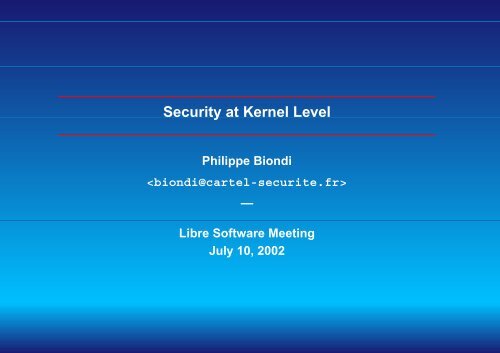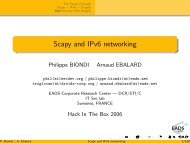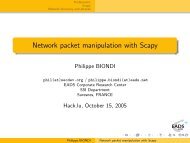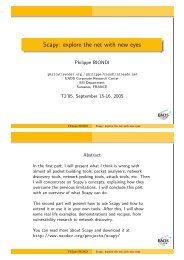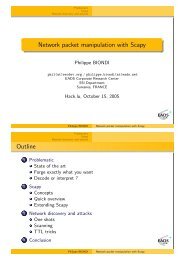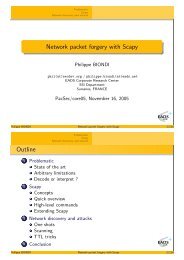Kernel security (Slides for LSM, July 2002) - SecDev.org
Kernel security (Slides for LSM, July 2002) - SecDev.org
Kernel security (Slides for LSM, July 2002) - SecDev.org
Create successful ePaper yourself
Turn your PDF publications into a flip-book with our unique Google optimized e-Paper software.
Security at <strong>Kernel</strong> Level<br />
Philippe Biondi<br />
<br />
—<br />
Libre Software Meeting<br />
<strong>July</strong> 10, <strong>2002</strong>
Outline 1<br />
Why ?<br />
◮ Context<br />
◮ A new <strong>security</strong> model<br />
◮ Conclusion<br />
How ?<br />
◮ Taxonomy of action paths<br />
◮ Defending kernel space<br />
◮ Filtering in kernel space<br />
Implementations<br />
◮ LIDS<br />
◮ Existing projects<br />
◮ <strong>LSM</strong><br />
CARTEL SÉCURITÉ — Philippe Biondi
Outline Why ? 2<br />
Why ?<br />
◮ Context<br />
◮ A new <strong>security</strong> model<br />
◮ Conclusion<br />
How ?<br />
◮ Taxonomy of action paths<br />
◮ Defending kernel space<br />
◮ Filtering in kernel space<br />
Implementations<br />
◮ LIDS<br />
◮ Existing projects<br />
◮ <strong>LSM</strong><br />
CARTEL SÉCURITÉ — Philippe Biondi
Why ? Context | New model | Conclusion 3<br />
We would like to be protected from<br />
◮ Fun/hack/defacing<br />
◮ Tampering<br />
◮ Resources stealing<br />
◮ Data stealing<br />
◮ Destroying<br />
◮ DoS<br />
◮ . . .<br />
CARTEL SÉCURITÉ — Philippe Biondi
Why ? Context | New model | Conclusion 4<br />
Thus we must ensure<br />
◮ Confidentiality<br />
◮ Integrity<br />
◮ Availability<br />
What do we do to ensure that ?<br />
◮ We define a set of rules describing the way we handle,<br />
protect and distribute in<strong>for</strong>mation<br />
➥ This is called a <strong>security</strong> policy<br />
CARTEL SÉCURITÉ — Philippe Biondi
Why ? Context | New model | Conclusion 5<br />
To en<strong>for</strong>ce our <strong>security</strong> policy, we will use some <strong>security</strong> software<br />
◮ Tripwire, AIDE, bsign, . . . <strong>for</strong> integrity checks<br />
◮ SSH, SSL, IP-SEC, PGP, . . . <strong>for</strong> confidentiality<br />
◮ Passwords, secure badges, biometric access controls, . . . <strong>for</strong><br />
authentication<br />
◮ . . .<br />
Can we trust them ? Do they work in a trusted place ?<br />
CARTEL SÉCURITÉ — Philippe Biondi
Why ? Context | New model | Conclusion 6<br />
The mice and the cookies<br />
Facts :<br />
◮ We have some cookies in a house<br />
◮ We want to prevent the mice from eating the cookies<br />
CARTEL SÉCURITÉ — Philippe Biondi
Why ? Context | New model | Conclusion 7<br />
The mice and the cookies<br />
Solution 1 : we protect the house<br />
◮ too many variables to cope with (lots of windows, holes, . . . )<br />
◮ we can’t know all the holes to lock them.<br />
◮ we can’t be sure there weren’t any mice be<strong>for</strong>e we closed the<br />
holes<br />
I won’t bet I’ll eat cookies tomorrow.<br />
Solution 2 : we put the cookies in a metal box<br />
◮ we can grasp the entire problem<br />
◮ we can “audit” the box<br />
◮ the cookies don’t care whether mice can break into the house<br />
I’ll bet I’ll eat cookies tomorrow.<br />
CARTEL SÉCURITÉ — Philippe Biondi
Why ? Context | New model | Conclusion 8<br />
Usual <strong>security</strong> model<br />
hardware<br />
trusted<br />
tripwire<br />
kernel space<br />
sendmail<br />
user<br />
space<br />
ssh<br />
CARTEL SÉCURITÉ — Philippe Biondi
Why ? Context | New model | Conclusion 8<br />
Usual <strong>security</strong> model<br />
hardware<br />
trusted<br />
tripwire<br />
kernel space<br />
sendmail<br />
user<br />
space<br />
ssh<br />
CARTEL SÉCURITÉ — Philippe Biondi
Why ? Context | New model | Conclusion 9<br />
<strong>Kernel</strong> <strong>security</strong> model<br />
tripwire<br />
hardware<br />
kernel space<br />
sendmail<br />
user<br />
space<br />
ssh<br />
trusted<br />
untrusted<br />
CARTEL SÉCURITÉ — Philippe Biondi
Why ? Context | New model | Conclusion 9<br />
<strong>Kernel</strong> <strong>security</strong> model<br />
tripwire<br />
hardware<br />
kernel space<br />
sendmail<br />
user<br />
space<br />
ssh<br />
trusted<br />
untrusted<br />
CARTEL SÉCURITÉ — Philippe Biondi
Why ? Context | New model | Conclusion 10<br />
To use this model, we must patch the kernel <strong>for</strong> it to<br />
◮ protect itself<br />
➥ trusted kernel space<br />
◮ protect other programs/data related to/involved in the <strong>security</strong><br />
policy<br />
CARTEL SÉCURITÉ — Philippe Biondi
Outline How ? 11<br />
Why ?<br />
◮ Context<br />
◮ A new <strong>security</strong> model<br />
◮ Conclusion<br />
How ?<br />
◮ Taxonomy of action paths<br />
◮ Defending kernel space<br />
◮ Filtering in kernel space<br />
Implementations<br />
◮ LIDS<br />
◮ Existing projects<br />
◮ <strong>LSM</strong><br />
CARTEL SÉCURITÉ — Philippe Biondi
How ? Taxonomy | Defence | Filtering 12<br />
Targets<br />
human<br />
physical <strong>security</strong><br />
physical <strong>security</strong><br />
action vehicle storage PROM, FPGA,...<br />
kernel<br />
MMU<br />
application<br />
application<br />
application<br />
CARTEL SÉCURITÉ — Philippe Biondi
How ? Taxonomy | Defence | Filtering 13<br />
Targeting storage or PROM with direct access to the box<br />
physical <strong>security</strong><br />
human<br />
1<br />
2<br />
physical <strong>security</strong><br />
action vehicle storage PROM, FPGA,...<br />
kernel<br />
MMU<br />
application<br />
application<br />
application<br />
CARTEL SÉCURITÉ — Philippe Biondi
How ? Taxonomy | Defence | Filtering 14<br />
Targeting an application accessible with keyboard, network, . . .<br />
3<br />
human<br />
physical <strong>security</strong><br />
physical <strong>security</strong><br />
action vehicle storage PROM, FPGA,...<br />
4<br />
kernel<br />
5<br />
MMU<br />
application<br />
application<br />
application<br />
CARTEL SÉCURITÉ — Philippe Biondi
How ? Taxonomy | Defence | Filtering 15<br />
Targeting storage or PROM through an accessible application<br />
3<br />
human<br />
physical <strong>security</strong><br />
physical <strong>security</strong><br />
action vehicle storage PROM, FPGA,...<br />
4<br />
7<br />
9<br />
5<br />
6 8<br />
kernel<br />
MMU<br />
application<br />
application<br />
application<br />
CARTEL SÉCURITÉ — Philippe Biondi
How ? Taxonomy | Defence | Filtering 16<br />
Targeting an unaccessible application through an accessible one<br />
3<br />
human<br />
physical <strong>security</strong><br />
physical <strong>security</strong><br />
action vehicle storage PROM, FPGA,...<br />
4<br />
kernel<br />
5<br />
11<br />
12<br />
MMU<br />
application<br />
10<br />
application<br />
application<br />
CARTEL SÉCURITÉ — Philippe Biondi
How ? Taxonomy | Defence | Filtering 17<br />
Targeting kernel directly or through an accessible application<br />
3<br />
human<br />
physical <strong>security</strong><br />
physical <strong>security</strong><br />
action vehicle storage PROM, FPGA,...<br />
4<br />
5<br />
13<br />
kernel<br />
MMU<br />
application<br />
application<br />
application<br />
CARTEL SÉCURITÉ — Philippe Biondi
How ? Taxonomy | Defence | Filtering 18<br />
Bugless interfaces<br />
◮ network stack, kbd input, . . .<br />
◮ kernel calls<br />
Defence<br />
◮ /dev/mem, /dev/kmem . . .<br />
◮ create_module(),<br />
init_module(), . . .<br />
Filtering<br />
◮ Queries to reach a storage device<br />
or PROMs, FPGAs, . . .<br />
◮ Queries to reach another process’<br />
memory<br />
human<br />
3 2<br />
1<br />
physical <strong>security</strong><br />
physical <strong>security</strong><br />
action vehicle storage PROM, FPGA,...<br />
4 7<br />
9<br />
kernel<br />
5 6 8 11 13 12<br />
MMU<br />
application 10 application<br />
application<br />
CARTEL SÉCURITÉ — Philippe Biondi
How ? Taxonomy | Defence | Filtering 19<br />
Is the bugless interface hypothesis ok ?<br />
◮ Protected mode mechanisms =⇒ harder to do programming<br />
faults (IMHO) (bugs are still possible, race conditions <strong>for</strong> ex.)<br />
linux/drivers/char/rtc.c<br />
static int rtc_ioctl(struct inode *inode, struct file *file, unsigned int cmd,<br />
unsigned long arg)<br />
{<br />
unsigned long flags;<br />
struct rtc_time wtime;<br />
[...]<br />
switch (cmd) {<br />
case RTC_ALM_SET: /* Store a time into the alarm */<br />
{<br />
unsigned char hrs, min, sec;<br />
struct rtc_time alm_tm;<br />
if (copy_from_user(&alm_tm, (struct rtc_time*)arg,<br />
sizeof(struct rtc_time)))<br />
return -EFAULT;<br />
CARTEL SÉCURITÉ — Philippe Biondi
How ? Taxonomy | Defence | Filtering 20<br />
How to protect kernel space against a user space intruder ?<br />
Block everything from user space that can affect kernel space.<br />
Attacks can come through :<br />
◮ system calls<br />
◮ devices files<br />
◮ procfs<br />
Few entry points, opened by the kernel<br />
◮ /dev/mem, /dev/kmem<br />
◮ /dev/port, ioperm and iopl<br />
◮ create_module(), init_module(), . . .<br />
◮ reboot()<br />
CARTEL SÉCURITÉ — Philippe Biondi
How ? Taxonomy | Defence | Filtering 21<br />
◮ /dev/mem, /dev/kmem and /dev/port protection :<br />
static int open_port(struct inode * inode,<br />
struct file * filp)<br />
{<br />
return capable(CAP_SYS_RAWIO) ? 0 : -EPERM;<br />
}<br />
CARTEL SÉCURITÉ — Philippe Biondi
How ? Taxonomy | Defence | Filtering 22<br />
◮ Module insertion control :<br />
asmlinkage unsigned long<br />
sys_create_module(const char *name_user, size_t size)<br />
{<br />
char *name;<br />
long namelen, error;<br />
struct module *mod;<br />
[...]<br />
if (!capable(CAP_SYS_MODULE))<br />
return -EPERM;<br />
CARTEL SÉCURITÉ — Philippe Biondi
How ? Taxonomy | Defence | Filtering 23<br />
What must we protect ?<br />
What is in memory<br />
◮ Processes (memory tampering, IPC, network<br />
communications, . . . )<br />
◮ <strong>Kernel</strong> configuration (firewall rules, etc.)<br />
What is on disks or tapes<br />
◮ Files<br />
◮ Metadata (filesystems, partition tables, . . . ), boot loaders, . . .<br />
Hardware<br />
◮ Devices (ioctl, raw access, . . . )<br />
◮ EPROMs, configurable hardware, . . .<br />
CARTEL SÉCURITÉ — Philippe Biondi
How ? Taxonomy | Defence | Filtering 24<br />
How to protect that ?<br />
◮ Queries are done only via the kernel<br />
◮ System calls, sysctls and devices drivers are a place of choice<br />
<strong>for</strong> controlling accesses<br />
➥ We have to modify their behaviour consistently to be able to<br />
en<strong>for</strong>ce a complete <strong>security</strong> policy.<br />
CARTEL SÉCURITÉ — Philippe Biondi
How ? Taxonomy | Defence | Filtering 25<br />
A good way is to use a modular architecture to control kernel calls :<br />
there will be<br />
An en<strong>for</strong>cer component<br />
A decider component<br />
◮ Lots of access control policies (DAC, MAC, ACL, RBAC,<br />
IBAC, . . . )<br />
decider<br />
component<br />
app<br />
en<strong>for</strong>cer<br />
component<br />
syscall<br />
CARTEL SÉCURITÉ — Philippe Biondi
How ? Taxonomy | Defence | Filtering 26<br />
How to add the en<strong>for</strong>cer code to the kernel calls ?<br />
◮ kernel call interception<br />
◮ kernel call modification<br />
ex: system call anatomy :<br />
user space kernel space user space<br />
open()<br />
chmod()<br />
app<br />
dispatching<br />
code<br />
kill()<br />
execve()<br />
dispatching<br />
code<br />
app<br />
socketcall()<br />
CARTEL SÉCURITÉ — Philippe Biondi
How ? Taxonomy | Defence | Filtering 27<br />
Syscall interception example : Medusa DS9<br />
linux/arch/i386/kernel/entry.S<br />
[...]<br />
GET_CURRENT(%ebx)<br />
cmpl $(NR_syscalls),%eax<br />
jae badsys<br />
#ifdef CONFIG_MEDUSA_SYSCALL<br />
/* cannot change: eax=syscall, ebx=current */<br />
btl %eax,med_syscall(%ebx)<br />
jnc 1f<br />
pushl %ebx<br />
pushl %eax<br />
call SYMBOL_NAME(medusa_syscall_watch)<br />
cmpl $1, %eax<br />
popl %eax<br />
popl %ebx<br />
jc 3f<br />
jne 2f<br />
1:<br />
#endif<br />
[...]<br />
testb $0x20,flags(%ebx)<br />
jne tracesys<br />
# PF_TRACESYS<br />
CARTEL SÉCURITÉ — Philippe Biondi
How ? Taxonomy | Defence | Filtering 28<br />
Syscall interception advantages<br />
◮ general system<br />
◮ low cost patch<br />
Drawbacks<br />
◮ kind of duplication of every syscall<br />
◮ need to know and interpret parameters <strong>for</strong> each different<br />
syscall<br />
◮ architecture dependent<br />
CARTEL SÉCURITÉ — Philippe Biondi
How ? Taxonomy | Defence | Filtering 29<br />
Syscall modification example : LIDS<br />
linux/fs/open.c<br />
asmlinkage long sys_utime(char * filename, struct utimbuf * times)<br />
{<br />
int error;<br />
struct nameidata nd;<br />
struct inode * inode;<br />
struct iattr newattrs;<br />
error = user_path_walk(filename, &nd);<br />
if (error)<br />
goto out;<br />
inode = nd.dentry->d_inode;<br />
error = -EROFS;<br />
if (IS_RDONLY(inode))<br />
goto dput_and_out;<br />
#ifdef CONFIG_LIDS<br />
if(lids_load && lids_local_load) {<br />
if ( lids_check_base(nd.dentry,LIDS_WRITE)) {<br />
lids_<strong>security</strong>_alert("Try to change utime of %s",filename);<br />
goto dput_and_out;<br />
}<br />
}<br />
#endif<br />
/* Don’t worry, the checks are done in inode_change_ok() */<br />
newattrs.ia_valid = ATTR_CTIME | ATTR_MTIME | ATTR_ATIME;<br />
if (times) {<br />
CARTEL SÉCURITÉ — Philippe Biondi
How ? Taxonomy | Defence | Filtering 30<br />
Syscall modification advantages<br />
◮ Syscall parameters already interpreted and checked<br />
◮ Great tuning power. We can alter the part of the syscall we<br />
want.<br />
Drawbacks<br />
◮ Lot of the 200+ syscalls must be altered<br />
CARTEL SÉCURITÉ — Philippe Biondi
How ? Taxonomy | Defence | Filtering 31<br />
To be out soon in the kernel : <strong>LSM</strong><br />
linux/kernel/module.c<br />
sys_create_module(const char *name_user, size_t size)<br />
{<br />
char *name;<br />
long namelen, error;<br />
struct module *mod;<br />
unsigned long flags;<br />
if (!capable(CAP_SYS_MODULE))<br />
return -EPERM;<br />
lock_kernel();<br />
if ((namelen = get_mod_name(name_user, &name)) < 0) {<br />
error = namelen;<br />
goto err0;<br />
}<br />
if (size < sizeof(struct module)+namelen) {<br />
error = -EINVAL;<br />
goto err1;<br />
}<br />
if (find_module(name) != NULL) {<br />
error = -EEXIST;<br />
goto err1;<br />
}<br />
/* check that we have permission to do this */<br />
error = <strong>security</strong>_ops->module_ops->create_module(name, size);<br />
if (error)<br />
goto err1;<br />
CARTEL SÉCURITÉ — Philippe Biondi
Outline Implementations 32<br />
Why ?<br />
◮ Context<br />
◮ A new <strong>security</strong> model<br />
◮ Conclusion<br />
How ?<br />
◮ Taxonomy of action paths<br />
◮ Defending kernel space<br />
◮ Filtering in kernel space<br />
Implementations<br />
◮ LIDS<br />
◮ Existing projects<br />
◮ <strong>LSM</strong><br />
CARTEL SÉCURITÉ — Philippe Biondi
Implementations LIDS | Other projects | <strong>LSM</strong> 33<br />
Linux Intrusion Detection System<br />
Self-protection<br />
Processes protection<br />
Files protection<br />
Online administration<br />
Special (controversial) features<br />
◮ Dedicated mailer in the kernel<br />
◮ Kind of portscan detector in the kernel<br />
CARTEL SÉCURITÉ — Philippe Biondi
Implementations LIDS | Other projects | <strong>LSM</strong> 34<br />
Self-protection<br />
Modules insertion/deletion, /dev/mem, . . . ,<br />
ioperm/iopl,. . . filtered<br />
Boot process protected<br />
◮ Can <strong>for</strong>bid the execution of non-protected programs (not<br />
flawless)<br />
Sealing mecanism<br />
◮ fsck or insmod can run when booting<br />
◮ no human intervention is needed to seal the protection<br />
◮ after the seal, we are in the working state. Everything is<br />
locked<br />
CARTEL SÉCURITÉ — Philippe Biondi
Implementations LIDS | Other projects | <strong>LSM</strong> 35<br />
Processes protection<br />
Rely on the linux capabilities bounding set<br />
◮ Hardware protection<br />
◮ Processes privacy (ptrace, promiscuous mode, . . . can be<br />
<strong>for</strong>bidden)<br />
◮ Network administration locked, . . .<br />
Daemons can be made unkillable<br />
Processes can be made invisible<br />
Processes can be granted capabilities<br />
lidsconf -A -s /usr/sbin/sshd \<br />
-o CAP_NET_BIND_SERVICE 22-22 -j GRANT<br />
CARTEL SÉCURITÉ — Philippe Biondi
Implementations LIDS | Other projects | <strong>LSM</strong> 36<br />
Files protection<br />
MAC-like approach :<br />
lidsadm -A -s /usr/sbin/httpd \<br />
-o /home/httpd -j READ<br />
Files identified by VFS device/inode ⇒ works on every fs<br />
CARTEL SÉCURITÉ — Philippe Biondi
Implementations LIDS | Other projects | <strong>LSM</strong> 37<br />
Online administration<br />
◮ LIDS can be disabled globally<br />
◮ LIDS can be reconfigured on the fly<br />
◮ LIDS can be disabled only <strong>for</strong> a shell and its children<br />
CARTEL SÉCURITÉ — Philippe Biondi
Implementations LIDS | Other projects | <strong>LSM</strong> 38<br />
Special features<br />
Mailer in the kernel<br />
◮ Can make a network connection (TCP or UDP)<br />
◮ Can send a scriptable session (mail, syslog, . . . )<br />
◮ Does not rely on anything in user space<br />
Scan detector in the kernel<br />
◮ Kind of interrupt driven ⇒ no load at all<br />
◮ Does not need the promiscuous mode<br />
◮ Works on all interfaces at the same time<br />
◮ Detect only connect/syn scans<br />
◮ Detect only what reach the TCP or UDP stack<br />
CARTEL SÉCURITÉ — Philippe Biondi
Implementations LIDS | Other projects | <strong>LSM</strong> 39<br />
LIDS general architecture<br />
Boot stuff<br />
<strong>Kernel</strong> image<br />
procfs stuff<br />
lidsadm<br />
init code<br />
AC data<br />
LIDS AC data<br />
init, rc, daemons<br />
decider<br />
component<br />
syscalls<br />
portscan<br />
detector<br />
processes<br />
syslog<br />
en<strong>for</strong>cer<br />
component<br />
Logging<br />
stuff<br />
<strong>Kernel</strong><br />
Mailer<br />
CARTEL SÉCURITÉ — Philippe Biondi
Implementations LIDS | Other projects | <strong>LSM</strong> 40<br />
Other projects<br />
◮ Openwall<br />
◮ GrSecurity<br />
◮ Medusa DS9<br />
◮ RSBAC<br />
◮ LoMaC<br />
◮ SE Linux<br />
◮ . . .<br />
CARTEL SÉCURITÉ — Philippe Biondi
Implementations LIDS | Other projects | <strong>LSM</strong> 41<br />
Openwall : Collection of <strong>security</strong>-related features <strong>for</strong> the Linux<br />
kernel.<br />
◮ Non-executable user stack area<br />
◮ Restricted links in /tmp<br />
◮ Restricted FIFOs in /tmp<br />
◮ Restricted /proc<br />
◮ Special handling of fd 0, 1, and 2<br />
◮ En<strong>for</strong>ce RLIMIT_NPROC on execve<br />
CARTEL SÉCURITÉ — Philippe Biondi
Implementations LIDS | Other projects | <strong>LSM</strong> 42<br />
GrSecurity : General Security <strong>for</strong> Linux<br />
◮ <strong>Kernel</strong> hardening from Openwall<br />
◮ ACL system<br />
CARTEL SÉCURITÉ — Philippe Biondi
Implementations LIDS | Other projects | <strong>LSM</strong> 43<br />
Medusa DS9 : Extending the standard Linux (Unix) <strong>security</strong><br />
architecture with a user-space authorization server.<br />
layer 1<br />
◮ Hooks in the original kernel code<br />
layer 2<br />
◮ kernel space code<br />
◮ called from hooks.<br />
◮ do basic permission checks<br />
◮ check <strong>for</strong> cached permissions<br />
◮ call the communication layer if necessary<br />
layer 3<br />
◮ communication layer<br />
◮ communicate with a user space daemon<br />
CARTEL SÉCURITÉ — Philippe Biondi
Implementations LIDS | Other projects | <strong>LSM</strong> 44<br />
User space daemon<br />
◮ decider component<br />
Miscellaneous<br />
◮ syscall interception<br />
◮ can <strong>for</strong>ce code to be executed after a syscall<br />
CARTEL SÉCURITÉ — Philippe Biondi
Implementations LIDS | Other projects | <strong>LSM</strong> 45<br />
RSBAC : Rule Set Based Access Control<br />
It is based on the Generalized Framework <strong>for</strong> Access Control<br />
(GFAC)<br />
All <strong>security</strong> relevant system calls are extended by <strong>security</strong><br />
en<strong>for</strong>cement code.<br />
Different access control policies implemented as kernel modules<br />
◮ MAC, ACL, RC (role control), FC (Functional Control), MS<br />
(Malware Scan), . . .<br />
CARTEL SÉCURITÉ — Philippe Biondi
Implementations LIDS | Other projects | <strong>LSM</strong> 46<br />
LOMAC : Low Water-Mark Integrity<br />
Initialization<br />
◮ Some specified directories (B) are high<br />
◮ Other directories (D) and sockets (E) are low<br />
Execution<br />
◮ Processes created from B are high<br />
process<br />
file<br />
socket<br />
◮ Processes created from D are low<br />
High<br />
A<br />
B<br />
Reading<br />
◮ A can read B. C can read D or E<br />
Low<br />
C<br />
D<br />
E<br />
◮ C can’t read B<br />
◮ if A reads D or E, A goes into the low level<br />
. . .<br />
CARTEL SÉCURITÉ — Philippe Biondi
Implementations LIDS | Other projects | <strong>LSM</strong> 47<br />
SE Linux : NSA’s Security Enhanced Linux<br />
Based on the Flask architecture<br />
(Flexible architecture <strong>security</strong> kernel)<br />
En<strong>for</strong>cer / decider components<br />
Pays a lot of attention to the change of the access control policy<br />
(revocation)<br />
CARTEL SÉCURITÉ — Philippe Biondi
Implementations LIDS | Other projects | <strong>LSM</strong> 48<br />
Linux Security Modules : to be included in 2.5<br />
◮ <strong>Kernel</strong> Summit 2001 : Linus decides that linux should support<br />
<strong>security</strong> enhancements<br />
◮ <strong>LSM</strong> patch is a set of hooks in the kernel syscalls<br />
➥ Linux kernel provide the en<strong>for</strong>cer component<br />
◮ Modular enough <strong>for</strong> the decider component to become a LKM<br />
CARTEL SÉCURITÉ — Philippe Biondi
The End 49<br />
That’s all folks. Thanks <strong>for</strong> your attention.<br />
You can reach me at<br />
<br />
These slides are available at<br />
http://www.cartel-securite.fr/pbiondi/<br />
CARTEL SÉCURITÉ — Philippe Biondi


